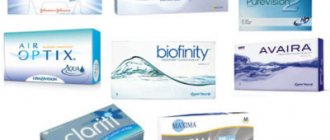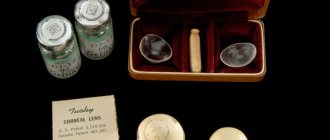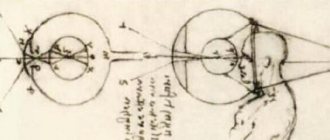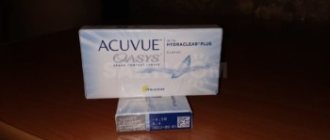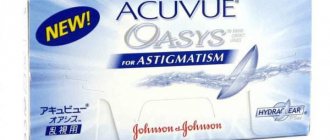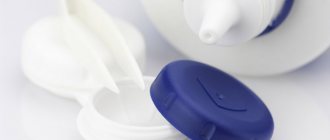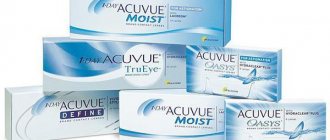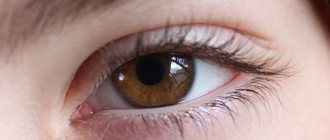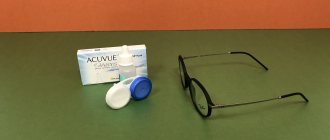Contact lenses are very popular today. They are made on the basis of hydrogel and silicone hydrogel polymers. What is the difference between these materials? How safe are they for the eyes? What advantages does each have? The list of questions can be continued. Read the answers to the most common ones in our article.
If ophthalmologists were to compile a list of questions frequently asked by patients, one of the most popular would probably be the following: “Which lenses are better: hydrogel or silicone hydrogel?” It is impossible to say unequivocally which is better, and even this would be wrong, because in each specific case certain lens models are used. By understanding the difference between hydrogel and silicone hydrogel optical products, you will get a complete understanding of these materials, their features, composition and vision correction capabilities.
What to look for when choosing hydrogel or silicone hydrogel lenses?
Many users know that the cornea of the eye does not have blood vessels and receives oxygen directly from the air. If you use contact lenses, the access of oxygen is somewhat slowed down, since optical products represent a certain barrier that prevents the cornea from being fully saturated with oxygen. However, such a comparison is very arbitrary and is used only to provide a complete picture of the structure of the visual organs. It will help you understand the main differences between the materials we are considering. The above statement was relevant for the very first lenses made from glass by grinding, as well as those made from polymethyl methacrylate. All models presented on the modern optics market allow oxygen to pass through to a greater or lesser extent.
It is important for the cornea of the eye not only to “breathe”, but also to have the necessary hydration. Under normal conditions, its level is ensured by tear fluid - a transparent transudate that accumulates in protein cavities and helps moisturize the cornea and neutralize microorganisms. Wearing lenses slows down the production of tear fluid, since they are a foreign body for our visual organs. That is why such an indicator as hydrophilicity, or moisture content, is very important - the ability of optical products to retain moisture, thereby preventing the risk of drying out the cornea.
Therefore, when choosing which lenses to buy, you should pay special attention to two parameters: oxygen permeability and moisture content, since comfort during use depends on them.
Hydrogel lenses
The main substance is water, so the lenses are not hard and do not cause discomfort when worn. They retain moisture and form a protective film. They have a small elastic modulus and oxygen transmission coefficient.
Products are manufactured for vision correction. The material used for production does not cause allergic reactions or rejection. It is soft, there is no feeling of discomfort and is not felt on the eyes.
The lenses are thin and do not move or curl when blinking. Do not interfere with the work of the upper eyelid. Hydrogel is an elastic and elastic material that does not cause additional pressure on the cornea.
Wearing period: one day, two weeks, monthly and quarterly, long-term use. The optics have a spherical design, but can also be found with an aspherical one.
Examples of lenses:
- DAILIES AquaComfort Plus;
- Biomedics 55;
- 1 day ACUVUE MOIST;
- Optima FW.
Flaws
Water evaporates quickly when worn, causing discomfort to the user. Some people have to carry moisturizing drops with them. These vision correction products have low oxygen permeability.
This is the main drawback. It does not allow flexible or extended wear of hydrogel lenses.
The optics are not suitable for night mode. Before going to bed, they are removed because CLs are not able to transmit oxygen sufficiently.
The contact lens does not have its own blood vessels; the necessary oxygen comes from the air. With prolonged use, hydrogel products lead to oxygen deficiency and the development of hypoxia.
Such optics quickly accumulate protein and fat deposits. It must be washed daily with a special solution.
Hydrogel contact lenses. What is the difference?
Hydrogel contact lenses, as their name implies, are based on hydrogel polymers that are characterized by good compatibility with ocular tissues. The more moisture they contain, the higher the oxygen permeability. These optical products are a kind of polymer frame filled with water - this is a hydrogel. They absorb water, thereby forming water channels through which oxygen is transmitted to the cornea. Due to their high water content, these contact lenses are very comfortable to use. As a rule, in their reviews, users note as the main drawback the occurrence of unpleasant sensations when wearing lenses in rooms with insufficient humidity or after working at a computer for a long time.
Hydrogel daily contact lenses Dailies AquaComfort Plus
Hydrogel contact lens models also have certain disadvantages. One of them is the rapid evaporation of moisture, which can lead to redness and burning in the eyes. The average level of oxygen permeability in these optical products is about 40 Dk/t. According to ophthalmologists, our eyes need 80 Dk/t for normal functioning.
That is why doctors recommend wearing lens models made from hydrogel materials no more than 8-10 hours a day and be sure to remove them before going to bed.
Another feature of these contact correction products is their softness. Of course, for some this is not a minus, but, on the contrary, a plus. However, due to the fact that they are quite soft, such lenses retain their original shape less well, which means they can be easily damaged.
What features do silicone hydrogel lenses have?
Compared to contact lenses developed on the basis of hydrogel polymers, these optical products contain silicone. It is responsible for delivering oxygen to the cornea and providing the eyes with the necessary level of oxygen permeability. Silicone hydrogel lenses have a higher breathability coefficient and are more comfortable for the cornea. As we said earlier, lenses made from hydrogel polymers, comparison with which will be very relevant, are quite soft, and those we are currently considering are more rigid. This allows optical products to remain more durable without losing their elasticity. In addition, silicone hydrogel contact lenses can be used not only in daytime, but also in flexible and extended modes, allowing you to leave contact lenses on your eyes and during sleep.
Silicone hydrogel monthly lenses PureVision 2 HD
Despite the obvious advantages, silicone hydrogel lenses are not without disadvantages. For example, they cannot be used by people predisposed to allergic reactions, which can be provoked by the silicone contained in optical products. In addition, it is less resistant to the accumulation of lipid deposits that can make optical products appear greasy.
In this regard, when choosing to wear this type of lenses, make sure to purchase a disinfectant solution.
The rigidity of silicone hydrogel lenses may be uncomfortable for some people, especially those who are just planning to switch to contact lenses after their usual glasses. However, as a rule, most users quickly get used to it and, on the contrary, consider it one of the advantages of these optical products.
Acuvue Oasys 1-day silicone hydrogel lenses
Which lenses are better? What is the difference between them?
It's time to summarize and determine the main differences between hydrogel and silicone hydrogel contact lenses. Optical products developed on the basis of hydrogel have a high moisture content, which increases wearing comfort. They moisturize the cornea well and resist the accumulation of protein deposits on the surface of the lenses. However, due to low oxygen permeability, they cannot be used for a long time, much less left on the eyes overnight. In addition, the water included in their composition tends to evaporate, which significantly reduces ease of use.
The first water-gradient lenses Dailies Total 1
As for the advantages that silicone hydrogel lenses have, the first thing is oxygen permeability, thanks to which they can be used for quite a long time.
From a physiological point of view, they are more preferable than hydrogel ones, but they also have certain disadvantages. For example, they can cause allergies in those users who are predisposed to it. Among other things, these optical products are susceptible to the formation of lipid deposits on their surface, and therefore require careful care using special solutions.
Features of both types of SCLs
Soft lenses for the eyes appeared in the late 60s of the 20th century and were made on the basis of hydrogels, hydrophilic polymers. In other words, the first development was hydrogel products, and silicone hydrogel is a new development in the product line , created to improve functional qualities. Modern lenses differ in the type of material, its composition and vision correction capabilities.
A hydrogel-based lens is a frame of a certain shape, consisting of 38%-78% water. Moisture is absorbed and water channels are formed, through which oxygen is supplied to the tissues of the organs of vision.
Features of hydrogel models:
- High coefficient of hydrophilicity;
- Good biocompatibility;
- Soft texture, so easy to get used to;
Minuses:
- Low level of resistance to mechanical damage;
- Low degree of oxygen permeability;
- Multi-day models are intended only for daytime wear, after which they need to be treated with a special solution and left in it for 8 hours.
IMPORTANT: Failure to comply with wearing lenses based on hydrogel polymers can lead to corneal swelling, decreased visual acuity and clouding, and can also provoke the appearance of various types of ophthalmological diseases.
Features of silicone hydrogel lenses:
- Good oxygen throughput;
- There is a type of product for continuous wear - up to 30 days;
- Does not cause dryness or a sandy effect in the eyes.
Minuses:
- Increased density and rigidity due to the presence of silicone in the composition;
- Allergic reactions to silicone are possible.
REFERENCE: Adding silicone to the hydrogel improved oxygen conductivity, which is very important for the normal functioning of the visual organs.
Technical names of silicone hydrogel from different manufacturers:
- Senofilkon;
- Enfilcon;
- Comfilcon;
- Califikon.
The hydrophilicity of contact optics is extremely important for the tissues of the visual organs, since the cornea of the eye must receive sufficient moisture.
A natural tool for maintaining moisture levels is tear fluid, and when wearing SCL, its production slows down. Initially, lenses with the addition of silicone were much inferior in this parameter to simply hydrogel lenses. But in recent developments, manufacturers have almost overcome this problem.
Which lenses are better - hydrogel or silicone hydrogel?
As you understand, it is not possible to give a definite answer to this question. Hydrogel and silicone hydrogel lenses have both pros and cons.
Only a qualified technician should select the material most suitable for a particular user's use.
Recently, contact lenses developed on the basis of silicone hydrogel have become especially popular. Modern manufacturers produce very high-quality products with excellent optical characteristics. Hydrogel lens models are not inferior to them, one of the most promising areas of development of which is giving them biocompatible qualities.
Which lenses are best for eyes?
Due to the characteristics of the materials and design, Air Optix Aqua contact lenses will still be the best choice for beginners, unless, of course, others are recommended by an ophthalmologist.
Buying Air Optix plus Hydraglyde lenses is worth it for those who travel frequently, forget, or are unable to regularly monitor the condition of their contact optics. Also, thanks to the long-term constant humidification system, Hydraglyde is great for dry rooms, such as an office with a heater or air conditioner. But remember that this model may take time to adapt and may cause discomfort in the first days of wearing.
You can buy classic Air Optix plus Hydraglyde, Air Optix Aqua or multifocal contact lenses from Alcon in the Healthy Vision online store with free delivery throughout St. Petersburg.
